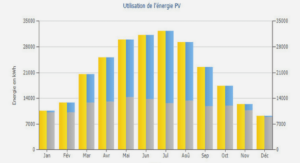ÉVOLUTION DE LA VÉGÉTATION ET DES SOLS FORESTIERS À L’ÉCHELLE LOCALE
Floristic inventories from 1972, 1991, and 2011 were available for 40 forest plots located in northeastern France. Detrended correspondence analysis (DCA) and variation partitioning were used to determine the relative importance of different drivers on the species composition of the studied forest. Changes in environmental conditions were inferred through changes in Ellenberg figures. Results: Species composition has reshuffled, with nitrophilic species increasing between 1972 and 2011. Soil pH mostly explained DCA axis1 variation (partial R2 RE=0.647), and soil nitrogen mostly explained DCA axis2 variation (partial R2 NE=0.152) over time. The acidification signal was non significant while eutrophication trend was significantly greater after 1991 (∆NE=+0.2). Flora bioindication revealed changes in light, and temperature and soil moisture. NE and LE are the figures changing more among the three surveys. Conclusions: The three surveys highlight differences in the rate/dynamics of changes.
Over the 40-year period in the study area, eutrophication has not slowed down whereas other environmental conditions, reflecting forest management and climate, exhibit significant changes. Global biodiversity is changing at an unprecedented rate as a complex response to several human-induced changes in the global environment (Vitousek et al., 1997b). By about the mid-20th century, global sulfur (S) and nitrogen (N) emissions from anthropogenic processes surpassed emissions from natural processes (Galloway, 2001), widely affecting terrestrial ecosystems (Aber et al., 1998), freshwaters systems (Schöpp et al., 2003), and soils chemistry (Falkengren-Grerup et Eriksson, 1990). Disturbance in forests appears as direct toxicity due to increased ammonium concentration (Van Den Berg et al., 2005), damage to vegetation (Bobbink et al., 2010), taxonomic homogenization (Keith et al., 2009), decline in species richness (McClean et al., 2011), and species reshuffling (Bernhardt-Römermann et al., 2007). At a European scale, a sharp decrease in S deposition has been observed since the 1980s, and some studies have already pointed out a recovery from anthropogenic acidification (Kirk et al., 2010; Riofrío-Dillon et al., 2012). However, N deposition has remained at a more or less constantly high level (EMEP, 2011). In France, inventories of atmospheric pollutants have reported that changes in emissions between 1980 and 2010 have shown a downward trend, with a strong, an important, and a significant reduction in SOx, NOx, and NH3, respectively (CITEPA, 2012). Under such conditions, recovery from the effects of eutrophying N compounds should be expected. Forest management systems have also changed, transitioning from coppice-with-standards to high forest management, thus affecting the species composition across European forests (Baeten et al., 2009). In France, forest conversion began before the 20th century, around 1860 (Degron, 1998). Consequently, changes in stand structure due to forest management system and stand maturation might confound the signal of other global changes. Forest dynamics have been reported as the cause of an apparent shift in species composition within forest ecosystems (Bodin et al., 2012).
Furthermore, the reshuffling of plant communities in response to contemporary climate warming has been pointed out, with the pattern of biotic responses varying greatly among species and geographic environmental conditions (Lenoir et al., 2010; Bertrand et al., 2011b; Crimmins et al., 2011). In addition, a greater lag has been reported in the response of lowland plant communities compared to that observed in highland forests facing climatic change, which has been explained by greater species tolerance and a lower opportunity for short- distance escape to track climate changes (Bertrand et al., 2011b). Hence, a combination of eutrophication with acidification, forest management, stand dynamics, and climate change are assumed to be major drivers of long-term vegetation changes and plant loss (Sala et al., 2000; Van Calster et al., 2007; Bertrand et al., 2011b).
Tracking such long-term human-induced changes is particularly difficult due to the limited historical data. Consequently, their effects in reshuffling of species composition have been studied by experimental (Nordin et al., 2005; Clark et al., 2009) or observational approaches. The latter includes studies along geographical gradients, i.e., spatial comparison (Smart et al., 2003; Duprè et al., 2010; Stevens et al., 2011a), or by resurvey of permanent or semi-permanent plots, i.e., temporal comparison (Diekmann et al., 1999; Hédl, 2004; Lenoir et al., 2010). Experimental and observational approaches have certain shortcomings due to the simultaneous occurrence of other determinant environmental factors (Verheyen et al., 2012). Despite this, it has been reported that changes induced by atmospheric pollution, local forest dynamics and management (Decocq et al., 2005; Baeten et al., 2009; Lenoir et al., 2010), and/or climate warming (Bertrand et al., 2011b) could be detected (Verheyen et al., 2012). In turn, these factors may influence light intensity, soil temperature and moisture, and nitrogen availability (Diekmann et al., 1999),





